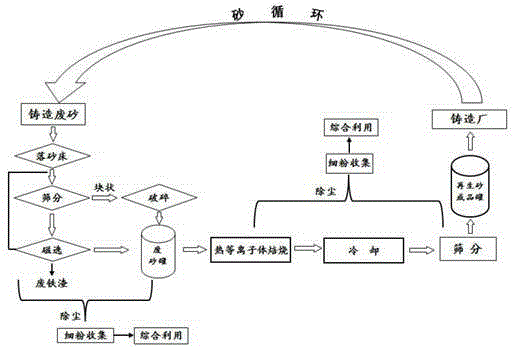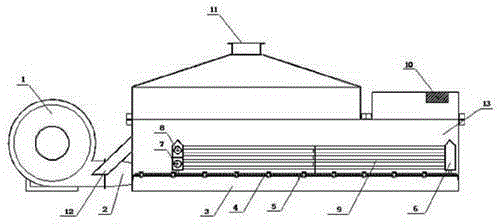Reclaiming method for cast waste sand hot plasmas
A thermal plasma and plasma technology, applied in casting molding equipment, cleaning/processing machinery of casting mold materials, manufacturing tools, etc., can solve the problems of insufficient regeneration and recycling ratio, environmental hazards, low roasting temperature, etc., and achieve Reduce the cost of comprehensive utilization of resources, reduce investment and operating costs, and achieve excellent comprehensive performance
- Summary
- Abstract
- Description
- Claims
- Application Information
AI Technical Summary
Problems solved by technology
Method used
Image
Examples
Embodiment 1
[0050] The regeneration of mixed wet waste sand thermal plasma includes the following process steps:
[0051] (1) Pretreatment
[0052] The wet-type waste sand infiltrated into the resin sand core (referred to as "mixed-type wet waste sand") undergoes pretreatment processes such as screening, crushing, magnetic separation, and dust removal to obtain pretreated waste sand with a particle size of 1.5mm. stored in waste sand tanks;
[0053] (2) Thermal plasma roasting
[0054] The pretreated waste sand enters the thermal plasma generator through quantitative feeding for roasting. The voltage of the thermal plasma generator is 800V, the temperature of the thermal plasma torch is 2500°C, the surface temperature of the waste sand is 1500°C, and the heating time of the waste sand is 15 minutes. The tail gas and fine powder can be discharged up to the standard after being cooled and directly processed by the pulse dust collector, and there is no need for post-treatment such as tail ...
Embodiment 2
[0070] The regeneration of alkaline phenolic resin waste sand thermal plasma includes the following process steps:
[0071] (1) pretreatment: with embodiment 1;
[0072] (2) Thermal plasma roasting
[0073] The pretreated waste sand enters the thermal plasma generator through quantitative feeding for roasting. The voltage of the thermal plasma generator is 2000V, the temperature of the thermal plasma torch is 3500°C, the surface temperature of the waste sand is 1800°C, and the heating time of the waste sand is 15 minutes. The tail gas and fine powder can be discharged up to the standard after being cooled and directly processed by the pulse dust collector, and there is no need for post-treatment such as tail gas concentration and secondary combustion. The specific tail gas emissions are shown in Table 4;
[0074] (3) cooling: with embodiment 1;
[0075] (4) Screening: with embodiment 1;
[0076] The specific regeneration technical indicators are shown in Table 2.
Embodiment 3
[0088] The regeneration of thermal plasma of coated sand waste sand includes the following process steps:
[0089] (1) pretreatment: with embodiment 1;
[0090] (2) Thermal plasma roasting
[0091] The pretreated waste sand enters the thermal plasma generator through quantitative feeding for roasting. The voltage of the thermal plasma generator is 5000V, the temperature of the thermal plasma torch is 3000°C, the surface temperature of the waste sand is 1200°C, and the heating time of the waste sand is 10 minutes. The tail gas and fine powder can be discharged up to the standard after being cooled and directly processed by the pulse dust collector, and there is no need for post-treatment such as tail gas concentration and secondary combustion. The specific tail gas emissions are shown in Table 4;
[0092] (3) cooling: with embodiment 1;
[0093] (4) Screening: with embodiment 1;
[0094] The specific regeneration technical indicators are shown in Table 3.
PUM
 Login to View More
Login to View More Abstract
Description
Claims
Application Information
 Login to View More
Login to View More - R&D
- Intellectual Property
- Life Sciences
- Materials
- Tech Scout
- Unparalleled Data Quality
- Higher Quality Content
- 60% Fewer Hallucinations
Browse by: Latest US Patents, China's latest patents, Technical Efficacy Thesaurus, Application Domain, Technology Topic, Popular Technical Reports.
© 2025 PatSnap. All rights reserved.Legal|Privacy policy|Modern Slavery Act Transparency Statement|Sitemap|About US| Contact US: help@patsnap.com



